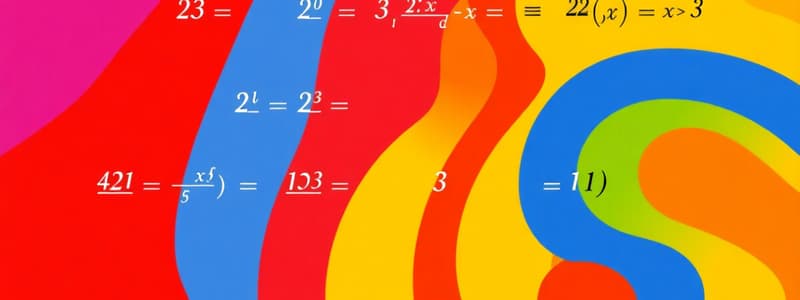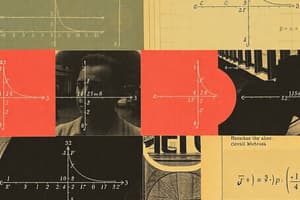Podcast
Questions and Answers
What defines a consistent system of equations?
What defines a consistent system of equations?
- It has multiple solutions but not infinite.
- It has only one unique solution.
- It has at least one solution. (correct)
- It has no solutions.
In which case does a system of linear equations have a unique solution?
In which case does a system of linear equations have a unique solution?
- When the equations intersect at two points.
- When the planes defined by the equations are parallel.
- When the equations intersect at exactly one point. (correct)
- When the equations represent parallel lines.
Which of the following does NOT represent a system of linear equations?
Which of the following does NOT represent a system of linear equations?
- $3x + 4y = 12$
- $y = 3x^2$ (correct)
- $2x - y = 1$
- $x + 2y = 4$
What is the graphical representation of a system of equations with no solutions?
What is the graphical representation of a system of equations with no solutions?
What is the significance of row echelon form in solving a system of linear equations?
What is the significance of row echelon form in solving a system of linear equations?
Which operation is NOT valid while performing row reduction on a matrix?
Which operation is NOT valid while performing row reduction on a matrix?
How are infinite solutions represented in a system of linear equations?
How are infinite solutions represented in a system of linear equations?
What best describes an inconsistent system of equations?
What best describes an inconsistent system of equations?
What can be concluded if the vector w is not in the span of vectors v1 and v2?
What can be concluded if the vector w is not in the span of vectors v1 and v2?
What is true about two noncollinear vectors v and w?
What is true about two noncollinear vectors v and w?
When can we ignore the right-hand side when solving the equation Ax = 0?
When can we ignore the right-hand side when solving the equation Ax = 0?
What happens to the span when a linearly independent vector is added to a set of vectors?
What happens to the span when a linearly independent vector is added to a set of vectors?
For a set of vectors to be considered linearly dependent, which condition must hold?
For a set of vectors to be considered linearly dependent, which condition must hold?
In which scenario will the homogeneous equation Ax = b have a nontrivial solution?
In which scenario will the homogeneous equation Ax = b have a nontrivial solution?
If vectors v and w are in span {u, v}, which of the following can be inferred about their linear independence?
If vectors v and w are in span {u, v}, which of the following can be inferred about their linear independence?
What is the consequence of having three vectors {v, w, u} that are linearly dependent?
What is the consequence of having three vectors {v, w, u} that are linearly dependent?
Flashcards are hidden until you start studying
Study Notes
Linear Algebra
- Linear refers to lines, planes, etc.
- Algebra refers to solving equations with unknowns.
- A system of linear equations is a set of equations with the same variables, where each equation represents a line or plane in a multi-dimensional space.
- A system of linear equations can be solved both algebraically (by manipulating equations) and geometrically (by visualizing the intersection of lines or planes).
- Examples of linear equations:
- x + y = 5
- 2x - 3y = 1
- 4x + 2y - z = 7
- Examples of non-linear equations:
- x² + y² = 9
- y = sin(x)
- A system of linear equations can have:
- One solution (unique solution): The lines or planes intersect at a single point.
- No solution (inconsistent system): The lines or planes are parallel and do not intersect.
- Infinitely many solutions: The lines or planes coincide (overlap).
- The elimination method is a technique to solve systems of linear equations by eliminating variables through algebraic manipulations.
- Row reduction is a systematic process used to transform a system of linear equations into an equivalent system that is easier to solve.
- A matrix is a rectangular array of numbers arranged in rows and columns.
- An augmented matrix is a matrix that represents a system of linear equations, where the coefficients of the variables and the constants are arranged in a specific way.
- A matrix is in row echelon form when:
- All rows that contain only zeros are at the bottom.
- The first nonzero element (pivot) in each nonzero row is 1.
- The pivots are in a staircase pattern.
- Reduced row echelon form: A more simplified form of row echelon form where the pivot is the only nonzero element in its column.
- When a non-augmented column in a reduced row echelon form lacks a pivot, it indicates the system has multiple solutions.
- Span: The span of a set of vectors is the set of all possible linear combinations of those vectors.
- A vector is in the span of a set of vectors if it can be expressed as a linear combination of them.
- Linearly independent vectors: A set of vectors is linearly independent if no vector in the set can be expressed as a linear combination of the others.
- Linearly dependent vectors: If at least one vector in a set can be expressed as a linear combination of the others, the set is linearly dependent.
- Homogeneous equation: An equation where the constant term is zero (e.g., Ax = 0).
- The solution set of a homogeneous equation always includes the trivial solution (x = 0).
- The solution set of a non-homogeneous equation (Ax = b) is a translate of the solution set of the corresponding homogeneous equation (Ax = 0) by the particular solution 'p' (Ax = p).
Studying That Suits You
Use AI to generate personalized quizzes and flashcards to suit your learning preferences.




